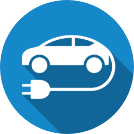As per Australia’s Electric Vehicle Council, EV drivers can save 70% on average when switching from fuel-fed cars to electric vehicles, which is almost $1,600 annually.
The Ev drivers can reduce that further if they use the solar charger solution.
EVs are better with maintenance as they require less servicing and periodic replacement of parts compared to fuel-fed vehicles.
For Commercial Charging units – We check the charging cables regularly to ensure they have not suffered any physical damage.
For Home Charging units – We monitor the health of the home EV Charger to keep it updated with the latest firmware to improve features and performance.
A home charging station includes a tethered Type 1 (J1772) or Mennekes (Type 2) cable that is connected to the chargepoint. As we understand, not all homes will have three-phase power, so this will confine your charging option to a maximum 7.4kW.
This is still ideal as you do not need rapid chargers similar to public ones, as you generally park your car and get that charged overnight.
Commercial EV Charging stations require a universal chargepoint with a type 2 socket. A type 2 socket is suitable for all car and plug types, provided they have the correct EV charging cable.
As we understand, the commercial premises will have three-phase electricity, which supports 22kW fast charging. Along with these, you would need a dedicated spot/area for electric vehicle parking only, where the chargers can be mounted/installed.
Installation FAQs
The 3-phase power is highly recommended for charging stations. It is understood that the commercial spaces would have 3-phase power, but not in all the residential houses. In such cases, we can still use the single-phase connection with a capacity of 32Amp.
The cable length will determine how flexible your parking options are. 3 meters is recommended.
If the charging current to be used is 16A or above, we instruct a cable with a minimum cross-section area of 2.5 mm2, allowing the vehicle to charge with a power of 11-22 kW. If we get the cables that are too thin, there is a risk that they might become hot and burn.
A commercial Installation or 3 phase connection needs a 5-conductor supply cable. The inner diameter of the cable depends on factors such as cable length, potential drop and surrounding temperature.
Our qualified Installation team can guide you through the requirements once you request a quote from us.
The residual current device (RCD) assists in balancing the electric current in the live and neutral wires and avoiding electric shocks. If RCD is not already integrated into the charging station, each charging station must be fitted with its own individual RCD. There is a diversity factor of 1.0. set for safety.
A residual current device of Type A is needed for every charging station that registers particular fault currents.
However, some electric cars will generate DC fault currents during charging. In such cases, suitable DC residual current protection must be installed. RCD Type B: A Type B RCD is “sensitive to all currents”, determines all types of AC and DC residual currents, and is suggested for charging station installation.

People First

Sustainability

Quality
Quality is paramount. We take pride in offering high quality products and services ensuring your solutions are built to last.